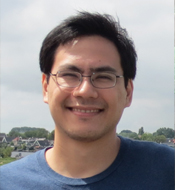Physics Ph.D Making Strides with Neutron Stars
 When prompted, Dr. Emanuele Berti describes his advisee, Hector Okada da Silva, as “one of the best students we’ve had in the physics department since I came to Ole Miss in 2009,” and da Silva’s rapidly-growing list of accomplishments supports that assesament.
When prompted, Dr. Emanuele Berti describes his advisee, Hector Okada da Silva, as “one of the best students we’ve had in the physics department since I came to Ole Miss in 2009,” and da Silva’s rapidly-growing list of accomplishments supports that assesament.
Da Silva earned his Bachelor’s and Master’s degrees in Physics at the Universidade Federal do Pará in Brazil, and it was there that he was first put into contact with Dr. Berti. Dr. Berti was working with an international network, funded by the European Union. Some of its nodes include institutions in Spain, Italy, and Portugal, along with, of course, Brazil and the University of Mississippi.
Since coming to Mississippi and working with Dr. Berti, da Silva has coauthored two papers that were published by the Classical and Quantum Gravity physics journal. The two papers pertained to neutron stars, which are very dense and cannot be described with traditional Newtonian gravity. The idea behind their research is to test general relativity’s predictions, comparing theories of gravity against observations in an astrophysical context. The end goal of streamlining current theories about gravity to yield more accurate predictions. One paper specifically aims to bypass the limitations of one theory and allow for it to still make broad predictions.
Said da Silva, “I’m not a theorist in the sense that I propose [theories]. I learn about them and explore the consequences of them in astrophysics, to see if the predictions are in accordance with what we actually see.”
In addition to being published in the formal journal, these two papers were also included on CQG+, the journal’s companion website. On CQG+, some of the more interesting papers from Classical and Quantum Gravity are paraphrased and elaborated upon for a wider readership, perhaps one with a less thorough background in physics. They were invited to write, as da Silva put it, “a less technical explanation” of their findings, which are now available online through CQG+ to a slightly more layman audience.
In the future, da Silva would like to work more on a project he and Dr. Berti are currently undertaking: taking theories of gravity and relativity that emerge from the cosmological branch of study and exploring what consequences they have in the context of astrophysics. According to da Silva, though the two fields of physics both study incredibly similar subject matter, there is relatively little communication between the two, but if a unified theory is to ever be found, it should apply equally to both fields.
This initiative comes as no surprise to Dr. Berti, who said, “He is very mature, independent and productive. At this point he comes up with his own ideas and starts his own collaborations; he operates more as a postdoc than as a PhD student.”
In terms of individual achievements, da Silva was recognized for giving the best student talk at the Gulf Coast Gravity Meeting organized by the American Physical Society last February.
While working with Dr. Berti was da Silva’s primary motivation in coming to the University of Mississippi, he has found a supportive environment in the Department of Physics and Astronomy overall. He said,”The department offers a good structure and a good environment for doing research. I’ve always gotten the support I need, both from the department and Emanuele as an advisor.”
For his part, Dr. Berti considers his role as da Silva’s advisor a pleasure.
“I collaborate with people at leading research institutions like Caltech and Princeton, and I think that Hector is at the level of the best physics students at those institutions,” he said. “I was very fortunate to be his advisor.”